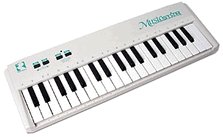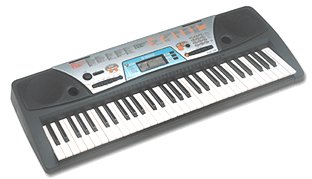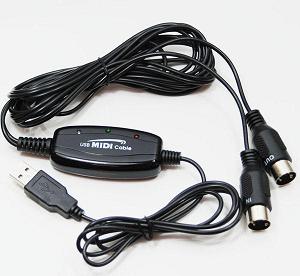 Reveal Music Star
Reveal Music StarWhat hardware do you need?
First of all you need a Windows PC and although you can use the PC keyboard for both chord and melody playing (in window PC Keyboard 1), a MIDI keyboard controller will be more convenient. And of course a MIDI cable to connect the two.
All kinds of MIDI keyboard controllers are used. From small "desktop" keyboards to full size digital piano's.
 Reveal Music Star
Reveal Music Star
On the lowest level, a keyboard like the Reveal Music Star can be used. If you can play reversed chords using only 12 keys, then the 37 keys may be enough for both chords and melody. But using PC-keys for the chords will be more suitable. It will leave all 37 keys available for melody playing. Choose userinterface PC Keyboard 1 in OMB for a small keyboard like this.
Most PC's now have no hardware synthesizer on board but are using Microsofts GS synthesizer that is included in Windows XP. This software synthesizer has a latency problem that isn't noticed when you use it to play MIDI files. But when you use it to play live, then you will notice there is a delay between the time you press a key and the time you actually hear the sound. For that reason the default synthesizer in OMB is JmSynth which is a reduced latency version of the Microsoft synthesizer. It uses the same wavetables but hasn't got the quarter second delay. You can also plug in DXi and VSTi softsynths.
 Yamaha
PSR170
Yamaha
PSR170
A low level arranger keyboard like the PSR170 can be upgraded to a high level arranger keyboard using One Man Band. The PSR170 has only 16 notes polyphony (maximum notes played simultaneously) which is not enough to play the styles created for its bigger brothers. But in OMB you can assign the accompaniment channels (9-16) to JmSynth and use the synth in the PSR only for melody and harmony voicing (channels 1- 8). Before using an arranger keyboard with OMB (or any other MIDI software) you must switch it from arranger mode (use it stand alone) to MIDI mode (use it with a computer). Also set local off. You don't want the pressing of keys have any direct effect on the arranger keyboard. How to accomplish this is explained in your keyboard manual. The Yamaha keyboard is only an example here. Although OMB uses styles in Yamaha format, the keyboards and synthesizer used may be Casio or Roland just as well.
 Yamaha Motif
Yamaha Motif
The Yamaha Motif is an excelent MIDI keyboard controller and synthesizer. It just lacks a real-time auto-accompaniment feature. But you can add that with One Man Band. There are also a lot of digital piano's that have a complete GM, GS or XG synthesizer on board, but no auto-accompaniment. Upgrade them with OMB.
 This will connect the MIDI ports on your music keyboard with a
USB port on your PC
This will connect the MIDI ports on your music keyboard with a
USB port on your PC
A MIDI cable will connect the round MIDI-IN and MIDI-OUT port of your MIDI keyboard controller to a USB port on your PC. Any shop that sells keyboards with MIDI capability should also be able to provide you with a MIDI cable. Modern MIDI-to-USB cables like the one shown above will automatically install the MIDI driver when plugged in. If you have USB connectors on your MIDI keyboard then you can use a plain USB cable but you must have the proper USB MIDI-driver installed. Keyboards with USB should be shipped with a CD-rom containing this driver. The MIDI drivers will become visible in OMB in the menu settings/MIDI-IN and MIDI-OUT.
Back to the One Man Band main page.